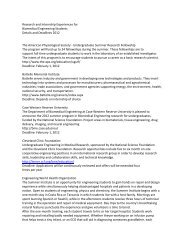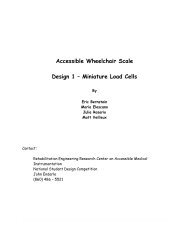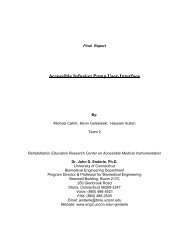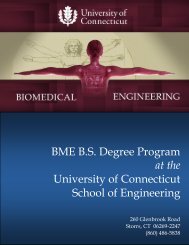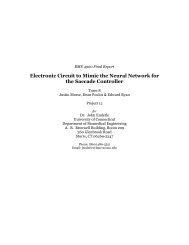Biomechanics Gait Analysis Lab - Biomedical Engineering ...
Biomechanics Gait Analysis Lab - Biomedical Engineering ...
Biomechanics Gait Analysis Lab - Biomedical Engineering ...
You also want an ePaper? Increase the reach of your titles
YUMPU automatically turns print PDFs into web optimized ePapers that Google loves.
The following table gives the dimensions for the LEMO<br />
connector shown in Figure 46.<br />
Metric A B e E M Nmax S1 S3<br />
mm. 12.0 12.5 M9X0.6 2.4 2.5 18.3 8.2 11.0<br />
in. 0.47 0.49 - 0.09 0.10 0.72 0.32 0.43<br />
Table 4: Measurements for Figure 46A<br />
Common (V o<br />
)<br />
Heal<br />
5 th Metatarsal<br />
Toe<br />
1 st Metatarsal<br />
Figure 47: Female LEMO Lead Wire Layout<br />
Telemetry<br />
The purpose of telemetry is to reduce the amount of wires<br />
and allow the freedom of movement that cannot be achieved<br />
using wires that are directly connected to a computer. The<br />
telemetry system is comprised of a transmitter box and<br />
receiver box. The transmitter box includes the 418MHz<br />
transmitter/encoder chip (TXE-418-KH), 10-pin dip switch<br />
(SDA10H1KD), and 418MHz Splatch antenna (ANT-418-SP-1),<br />
which is shown in Figures 48-49. The box also has the<br />
circuitry that provides the data to be sent wirelessly.<br />
The receiver box has a 418MHz receiver/decoder chip (RXE-<br />
418-KH), 10-pin dip switch (SDA10H1KD), and 418MHz Splatch<br />
antenna (ANT-418-SP-1), which is shown in Figures 50-51.<br />
The receiver/decoder chip is also wired to connect to the<br />
BNC-2120, which will be described later in the National<br />
Instruments equipment section. The transmitter/encoder and<br />
receiver/decoder are powered by a 3V coin battery at pin 5<br />
for both chips.<br />
Page 54




